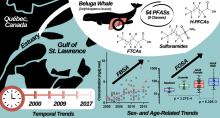| Title | Disclosing Environmental Ligands of L-FABP and PPARγ: Should We Re-evaluate the Chemical Safety of Hydrocarbon Surfactants? |
| Publication Type | Journal Article |
| Year of Publication | 2023 |
| Authors | Gong, Y, Yang, D, Liu, J, Barrett, H, Sun, J, Peng, H |
| Journal | Environ Sci Technol |
| Date Published | 2023 Aug 01 |
| ISSN | 1520-5851 |
| Abstract | Chemical contaminants can cause adverse effects by binding to the liver-fatty acid binding protein (L-FABP) and peroxisome proliferator-activated nuclear receptor γ (PPARγ), which are vital in lipid metabolism. However, the presence of numerous compounds in the environment has hindered the identification of their ligands, and thus only a small portion have been discovered to date. In this study, protein ffinity urification with ontargeted nalysis (APNA) was employed to identify the ligands of L-FABP and PPARγ in indoor dust and sewage sludge. A total of 83 nonredundant features were pulled-out by His-tagged L-FABP as putative ligands, among which 13 were assigned as fatty acids and hydrocarbon surfactants. In contrast, only six features were isolated when His-tagged PPARγ LBD was used as the protein bait. The binding of hydrocarbon surfactants to L-FABP and PPARγ was confirmed using both recombinant proteins and reporter cells. These hydrocarbon surfactants, along with >50 homologues and isomers, were detected in dust and sludge at high concentrations. Fatty acids and hydrocarbon surfactants explained the majority of L-FABP (57.7 ± 32.9%) and PPARγ (66.0 ± 27.1%) activities in the sludge. This study revealed hydrocarbon surfactants as the predominant synthetic ligands of L-FABP and PPARγ, highlighting the importance of re-evaluating their chemical safety. |
| DOI | 10.1021/acs.est.3c02898 |
| Alternate Journal | Environ Sci Technol |
| PubMed ID | 37527448 |
Environmental Chemical Biology

